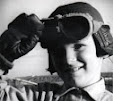 |
| Image courtesy Niven Family |
05.35 First day fighters on patrol. Cloud over coast 7/10 1500' & hazy. Our troops approaching shore for first landing. Warships bombarding shore & Le Havre. Patrolled out to sea. No flak, no Huns.10.35 Weather improved slightly. Landings made in St.Aubin area. Transports & tanks ashore. Heavy shelling from ships. Patrolled 1-6000'. No air activity.18.50 Weather over beaches very clear with high cloud. Masses of bombers heading inland. Many gliders on ground near Bavent. Terrific bombing SE Caen. (Badly knocked about) On way home passed glider train stretching from Le Havre - 10 m. S Worthing.
And remembering Tony Cooper who I met and who recently passed away.
On D-Day, 6th June 1944,Tony Cooper’s logbook shows that he flew twice. No 64 Squadron was tasked with providing ‘Low Beach Cover’ over the American assault. The Squadron ORB records that Cooper was allocated his personal Spitfire BM327, ‘SH-F’, for both sorties. He took off at 0430 hours for his first sortie of the day, as part of a 13 aircraft formation, providing “Fighter Cover for Utah Beach” and landed back after a total of 2 hours and 40 minutes airborne (the first hour recorded as night flying). The naval barrage was so intense that it was not safe to be over the coast and the Wing Leader withdrew the formation to a safer distance. Cooper’s remarks in his logbook give an interesting picture of the confusion that reigned and suggest that the invasion stripes, so painstakingly painted on by the ground crew, were not entirely effective: “Navy shelling coast defences – first landing made by the troops at 0620 hours. Nearly shot down by a Thunderbolt – Spitfire in front actually was – Another Spit hit by naval shell and blew up – General Brock’s benefit!”
On the evening of 6th June Tony flew his aircraft on another sortie over the invasion beaches, taking off at 2200 hours, this time tasked with, “Fighter Cover for Omaha Beach”. His comments in his logbook against this sortie read, “Hun bombers attacked invasion fleet – tremendous return fire from ships – one bomber destroyed.” He landed back at ten minutes past midnight – almost 18 hours after his first take-off that day – logging two hours and five minutes of night flying. When asked about night landings in the Spitfire on the short, temporary runways at Deanland, which were lit only by ‘goose-neck’ flares, Tony says, “I remember them well, with reasonably controlled terror, especially when it was raining!”













No comments:
Post a Comment